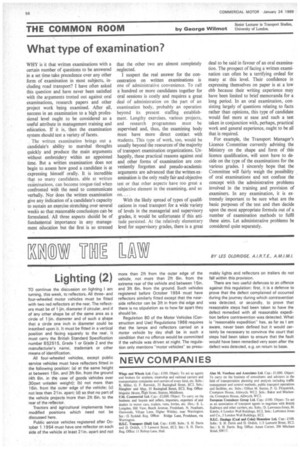MEM 741E BY LES OLDRIDGE, A.I.R.T.E., A.M.I.M.I.
Page 58

If you've noticed an error in this article please click here to report it so we can fix it.
Lighting (2)
TO continue the discussion on lighting I am turning, this week, to reflectors. All threeand four-wheeled motor vehicles must be fitted with two red reflectors at the rear. The reflectors must be of 1 lin. diameter if circular, and if of any other shape be of the same area as a circle of 14-in. diameter and of such a shape that a circle one inch in diameter could be inscribed upon it. It must be fitted in a vertical position and facing squarely to the rear. It must carry the British Standard Specification number BS2515, Grade 1 or Grade 2 and the manufacturer's name, trademark or other means of identification.
All four-wheeled vehicles, except public service vehicles must have reflectors fitted in the following position: (a) at the same height at between 15in. and 3ft 6in, from the ground (4ft 6in. in the case of goods vehicles over 30cwt unladen weight); (b) not more than 16in. from the outer edge of the vehicle; (c) not less than 21 in. apart: (d) so that no part of the vehicle projects more than 2ft 6in. to the rear of the reflector.
Tractors and agricultural implements have modified positions which need not be discussed here.
Public service vehicles registered after October 1 1954 must have one reflector on each side of the vehicle at least 21 in. apart and not more than 2ft from the outer edge of the vehicle, not more than 2ft 6in. from the extreme rear of the vehicle and between 15in. and 3ft 6in. from the ground. Such vehicles registered before October 1954 must have reflectors similarly fitted except that the nearside reflector can be 3ft in from the edge and there is no stipulation as to how far apart they should be.
Regulation 80 of the Motor Vehicles (Construction and Use) Regulations 1966 requires that the lamps and reflectors carried on a motor vehicle by day shall be in such a condition that no offence would be committed if the vehicle was driven at night. The regulation only mentions "motor vehicles" so presu
mably lights and reflectors on trailers do not fall within this provision.
There are two useful defences to an offence against this regulation: first, it is a defence to prove that the defect complained of occurred during the journey during which contravention was detected, or secondly, to prove that reasonable steps had been taken to have the defect remedied with all reasonable expedition before contravention was detected. What is "reasonable expedition" has, as far as I am aware, never been defined but it would certainly be necessary to convince the court that steps had been taken to ensure that the fault would have been remedied very soon after the defect was detected, e.g. on return to base.








































































































